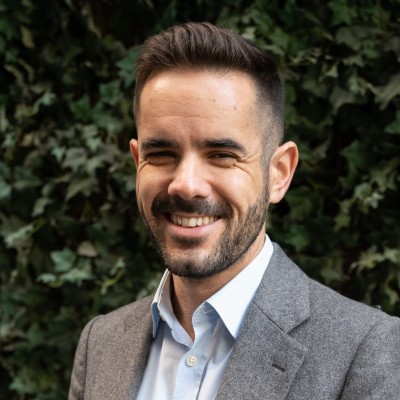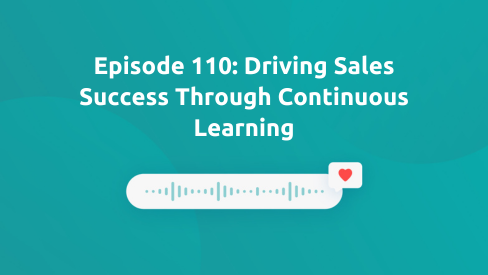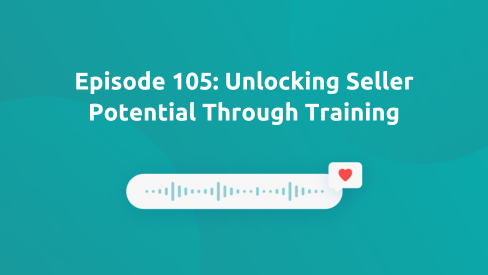A study conducted by Gartner states that change is the new constant and that only 34% of organizations successfully navigate change management. So what are some best practices for making sure change sticks within your organization? Training plays a key role.
Shawnna Sumaoang: Hi and welcome to the Win Win Podcast. I’m your host, Shawnna Sumaoang. Join us as we dive into changing trends in the workplace and how to navigate them successfully. Here to discuss this topic is Vincent Drapeau, director of sales training at Intralinks. Thanks for joining, Vincent! I’d love for you to tell us about yourself, your background, and your role.
Vincent Drapeau: Thank you, Shawnna. It’s my pleasure to be here. As you said, I’m the director of sales training for Intralinks. We are in the financial services tech world, so we really serve a tech component to financial services institutions. I manage a team of five, but I started as a sales trainer and that was already almost 10 years ago.
I jumped in a little bit by accident after having spent some time in the tech world, in that company, in their competitors and I learned the job of sales enablement and sales training on the go. I’ve seen the practice of sales enablement moving from L&D to sales, to becoming sales enablement, and I think we’ll be speaking about that today.
SS: Absolutely. On LinkedIn you actually share that you are, in quotes, inventing the future of revenue enablement, and with the future comes change. Can you share a little bit about how you think about inventing the future to adapt to change in your training programs?
VD: Yes. On my LinkedIn profile, I mentioned that I want to take part in inventing the future of sales enablement. Actually, this is stolen from Highspot themselves. As I said, I grew with the practice, and revenue enablement has grown a lot in the last 10 years, and we now have a multitude of vendors helping companies enable their sales force, and I think the reason behind it is because the selling motion, but also like the changes that that sales organization like ours have to face is increasing.
There is more and more change every year in the strategy. A lot more companies have to be agile in the market that we serve and have to rethink their strategy, maybe not like their long-term strategy all the time, but like every month, every quarter new elements, a new piece of strategy is evolving, or a new tool is being added in front of the salespeople. There has been a need to streamline a little bit how we equip salespeople so they can be reactive to change in their workspace.
SS: Absolutely. Now, Vincent, before Highspot, what did your training programs look like at Interlinks?
VD: Before Highspot, we were talking about training, and when I started, it was all about, ‘let’s put 400 people into a WebEx, and let’s tell them something for one hour’. People would stop what they are doing to join this WebEx, but not necessarily paying their full attention, probably multitasking at the same time, and some of them not joining. We would have a lot of issues tracking who’s joined, and who’s not joined. We were thinking about whether are we going to give them a recording of one hour of you talking. How are you going to make sure that they watched that recording if they didn’t join the live training? That’s what training used to look like. I mean, there was already some e-learning, there was already a bit more than those WebEx, but really that’s the world we come from, last minute, let’s organize a WebEx training, we want to communicate something to sales, let’s organize a one hour WebEx conversation.
SS: Very interesting. How would you say your training programs have evolved since deploying Highspot training and coaching, and back to my initial question, how has that helped you essentially invent the future for enablement at your company?
VD: Yes. I think what is very important in what Highspot provides, but in general, what you can try to do with a better sales enablement strategy or better training is to really embed the training component within everything else. The definition of a new initiative, why it’s important, what you are trying to achieve, and what the salesperson needs to learn and do differently.
It’s not all about training, there is an element of communication and if we are talking about new go-to-market initiatives, maybe penetrating a new industry or reinforcing messages on specific customer use cases. The salespeople need to use the material that they’ve learned or that they’ve used during their learning to then share it with their customers.
Highspot training and coaching, and Highspot in general, provides one single platform where the same user experience is used by salespeople, the same user interface is used to interact with content that I can share with the customer, content that I used for my own learning, my own education, and then maybe the practice environment where I’m going to practice how to deliver that content to customers.
I think that integration, that’s what has changed and that’s what helped us in providing more training. As I said earlier on, there is more and more change coming up, so every year a salesperson will go through new initiatives and new tools to learn multiple times so integration is very important.
SS: Absolutely. You teed up the next question perfectly, Vincent. How do you prepare reps to navigate change through training?
VD: I think that’s something I could also add back to the previous question. The idea of that one single platform that is used to host any type of communication document that a person needs to know allows us to integrate into the life of a salesperson from day one. I think if by day one you immerse them into an ecosystem and it happens to be supported by Highspot at Intralinks, but whatever an ecosystem that prepares them for communication and a learning experience, that prepares them for continuous change coming up across, but of course, change management is also a big communication effort.
Communicate as early as you can kick off, continue communicating and release your trainings before the change actually has to happen. For example, if you want new tools to go live on June 1st, release the training on May 15th and give them the time to get ready to learn before the actual event kicks off.
SS: I love that. Those are some great tips and tricks. Now I am curious, oftentimes putting together training means collaborating with a lot of subject matter experts across the organization. How do you collaborate with your SMEs and sales leaders to continuously improve your training programs?
VD: Yes, we are lucky at Interlinks to have a project management organization that really takes those questions early on in advance. They have built a very regular cadence to discuss with a very small working group where sales enablement is often invited first for our own education, but also to know what’s maybe changing and coming up. I think having that communication, that regular cadence where people at the sales involvement level are invited helps a lot to know what’s coming up and build the relationship with the SMEs.
When you need that specific SME for a specific initiative, you have to build a conversation and the communication or the relationship already. Our PM team also involves and invites sales leaders to those questions, and to those meetings, so that really helps as well to prepare the sales leader to integrate them into the change management or into the preparation of the training.
In my team, I have a trainer in each of our main geos and I get those trainers in front of the managers, and the sales leaders of every sub-location so that they constantly are in front of our sales leader building those relationships and making sure that messages are reinforced and then new messaging coming up can be anticipated.
SS: Outside of delivering lessons and courses to your sales reps, how do you reinforce training after it’s been rolled out? How do you involve frontline managers to continue to help reinforce training through their coaching efforts?
VD: Great question. I mean, this is the key, right? Delivering lessons and courses is just not enough, we have to think about that ecosystem of what is your learning objective, what will be a component of your learning, and there is the lesson and the course on the platform, but maybe there is also still an element of live training. Nowadays, we are really looking into, how you use that live in-person or virtual Zoom teams component of your training.
Do you use one hour of your sales reps’ time to tell them what to learn, or do you actually use that time to make them practice in small groups? Something they’ve learned, maybe, for example, in e-learning as pre-work. You can use tools such as sales plays, which is a feature of Highspot that really organizes content either as a pre-work, or post-work for them to really categorize the information they need to learn where they can say to customers, where they can show to customers, share with the customer.
Then, for management involvement, this is very important. I think we’ll touch on that in a minute, but you try to really hone on the managers to get them to try completion and show completion of training and to help them. Maybe you give them some activities around grading some video questions, for example, such as a pitch or a demo. Of course, you can let the manager and you encourage the manager to continue the reinforcement of the learning through role play, for example, and I think that’s something that’s coming into the platform that we are waiting for a little bit more. How do we encourage the role play setting directly within the Highspot learning environment so that you ensure yourself, as a sales department person, that the manager indeed did their follow-up part of the training? That’s coming up.
SS: I love that. You joined us at our annual user conference last fall, Spark ‘22, and you were recognized for driving incredible adoption of training and coaching at Interlinks. Can you share some best practices therefore how you drive the adoption of your training programs?
VD: Yes, absolutely. First of all, it was an honor to be recognized at Spark ‘22, so thank you again. I think what happened is that when we joined Highspot Training and Coaching, we were Highspot users already, but we did have our training and coaching on another platform and we migrated, but we already had some very strong, robust processes around training reinforcement.
As I was preparing for this podcast, the key part is something that we want to continue to re-think is to make training mandatory. On an onboarding program, it’s pretty easy. You have a person joining and for the first two months, all they can really do is to be trained. You can easily put in place some processes to track the fact that the mandatory training is completed. We do a welcome call personalized for every new hire on day one to make sure that they get started and that they do utilize the material that has been crafted for and consistently updated.
Beyond onboarding, helping the managers to track completion, to ensure completion, to give them all the tools together really help you to have great immersion of training and I think that’s what gives us such great numbers that Highspot recognizes is because we had those processes to help enforcement completion of training.
I think that’s a caveat for the future. I think we want to be able to rethink onboarding a little bit in the future. Today, we have that attention span of a new hire for two months, but we try to cram way too much information for a new hire on that onboarding program because we want to use that advantage of, it’s mandatory, it’s two months, it’s the time where it makes more sense for them to concentrate on training more than field activities, for example, but it’s also not enough because you give them skills that they are not maybe able to hone right away.
You would like to be able to elaborate more on mandatory post-onboarding months three to six for example, or six months to one year, so that’s going to be our work for the rest of 2023 and 2024 thinking of how we continue and improve there.
SS: This is really interesting, Vincent. To drill a little bit deeper, I’d love to understand what are the most important initiatives that you have focused on training reps in, and what is an example of how you’ve done this?
VD: As I said earlier on, there is so much more to absorb in a typical year for a salesperson in tech specifically, I think it’s the same in many other industries than it used to be before. From sales kickoff in January, and February, all the way down to the end of your fiscal year. As a sales rep, you know that what you will be doing in Q1 might be slightly different than what you’re gonna be doing in Q2, Q3, and Q4 because either because the industry, our marketing team, or our go-to-market team, will provide you access to new material to target or retarget specific subset of customers.
For example, we serve the financial services world. An event like the latest banking crisis that we’ve seen in the US in March or April, how do we respond to that and how can we do a small campaign to a subset of sales reps so that they can target their messages to the right person at the right time to seize the opportunities that may arise from a situation like this.
In this type of situation, depending on the market, it happens all the time. To this, you add new products that you try to go to market with so that you create more value for your customers and then, then you add the new tools that you want to develop and deploy for salespeople to improve their productivity, so all of a sudden, during your year, there is a lot to learn and a lot to navigate through, so streamlining is very important.
SS: Absolutely. Now on the topic of streamlining, what overall business metrics do you use to really understand if your training programs are having the desired impact, and how do you correlate that success with the work that you’re doing in Highspot?
VD: That’s the million-dollar question all the time. What’s the return on investment of training, of a trainer, or of a platform that you purchase for training? It’s always difficult. I think we’re not talking about marginal gain because I think it’s much more than this. It’s sometimes difficult to look at metrics for each individual training program training campaign, but you have to look at the idea of the learning culture that you are building in your sales organization.
Do people adapt to change and adapt to change quickly to all those numerous changes that we were mentioning above? I think you can measure that. Do people feel completely lost after two months of launching a go-to-market initiative? Do you see the result in your opportunity creation in that particular field? There is a lot that can be measured.
Highspot helps with that. With the pitching, linking pitching documents to customers, to those customers that are currently registered or recorded in Salesforce as being tagged on that opportunity, you can start putting dollar amounts behind the way you govern your sales portal, like plays, so that that really helps to really show the impact of programs in general. I think training alone is not enough, it’s really like how the programs impact the company and the numbers.
SS: Wonderful. The last question for you, Vincent. This has been fantastic. To close, what would you say one thing is that you’d like our audience to take away from this conversation around what good sales training looks like.
VD: It’s all about that integration, so you want to integrate your training into your overall learning objective. What do you want to accomplish? What do you want your reps to do differently today than before? How are you going to make sure that beyond that learning moment, you’re going to make sure that you’re going to measure that it’s actually being done in the field?
There’s that element of integration, and then the second element is integrating training itself into the overall window of how people consume information and consume change, and training is only one element of it. Think of the wider vision, not just the listening, not just the course, not just sales training or sales enablement within the company, but the overall picture of everything.
SS: I love that. Vincent, thank you so much for joining us today.
VD: Thank you for having me.
SS: Thank you for listening to this episode of the Win Win podcast. Be sure to tune in next time for more insights on how you can maximize enablement success with Highspot.



